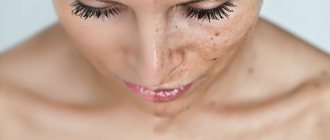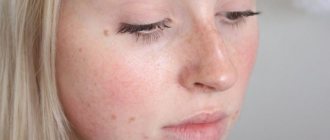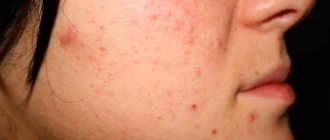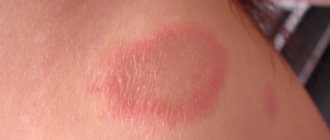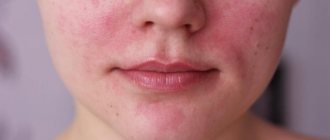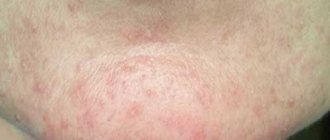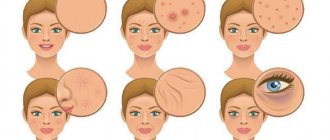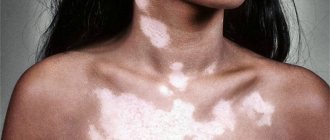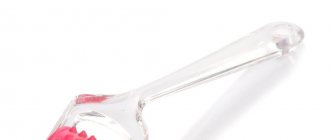All people, and women in particular, want to look beautiful. Therefore, all kinds of sores on the face greatly poison life. Sometimes they become the reason for reluctance to leave home and visit crowded places.
Therefore, correct identification of the varieties and further treatment of skin imperfections associated with a particular disease is extremely important.
And also an equally significant activity is identifying the cause of the sore on the face. Our article, based on medical knowledge and research, will help you with everything, so that you can properly treat various sores on your face and temporary skin defects.
____________________________
Why do sores occur on the face?
There are a huge number of reasons for the occurrence of various types of inflammation on the face. However, they are all divided into:
Sores on the face caused by deviations in the internal organs; skin diseases.
In general, most sores on the face are caused by an unhealthy lifestyle and poor diet: drinking alcohol, smoking, and consuming unhealthy, fatty foods.
But also failures of any system of the human body can cause the appearance of various kinds of ulcers, acne, etc.
They are the following diseases:
Blood-vascular system; digestion; reproductive system.
Also, sores on the face develop as a result of various dermatological diseases.
, which develop as a result of non-compliance with personal hygiene rules or infection from a carrier of the infection.
Causes
Acne is most often located on the T-zone - the nose and forehead. Acne also multiplies on the chin; in severe cases, even the cheeks and areas under the eyes are affected. In adolescence, acne is the norm, after 20 years it is a problem.
On the face
Diseases on the face in adults appear due to hormonal disorders or pathologies of the gastrointestinal tract. Any type of acne is a sign of improper functioning of the digestive system, a lack of vitamin D, Omega 3 and other microelements.
Causes of skin diseases with acne and flaky patches:
- improper functioning of hormones of the reproductive and endocrine system;
- improper cosmetic care;
- diseases of the digestive system;
- the presence of parasites in the body;
- weakened immune defense;
- psycho-emotional instability;
- smoking and alcoholism.
Dermatitis or herpes most often develops on the face. Cuperosis is damage to the venous vascular network, stars appear on the skin under the eyelids, rosacea is the formation of pink spots. Chloasma and seborrhea are less common.
On the head
The scalp is affected even more often than the face. If the hair part itches, flakes of dandruff and pimples appear - this is a sign of illness.
The main causes of skin damage:
- stress;
- restructuring of the body after pregnancy and childbirth;
- infection by fungi and other organisms;
- spread of infection from the face;
- bad habits;
- hormonal problems.
Seborrhea, psoriasis, lichen and other diseases are accompanied by prolonged hair loss, itching of the scalp and fragility, weakening of the curls. A trichologist, cosmetologist or dermatologist will identify the exact pathogen and prescribe treatment for skin diseases on the face or head.
On the body
The human body consists of beneficial and harmful microorganisms. Parasitic bacteria provoke the growth of bad tissues. Psoriasis affects more than 80% of the entire body.
Ringworm, melanoma, seborrhea, allergic dermatitis, mycosis scabies and other types of eczema may appear on the hands. The feet are affected by warts, calluses, and hyperkeratosis. Skin diseases of the legs quickly become chronic.
What are the types of sores on the face?
Sores on the face are divided similarly to the diseases that caused them. Major skin diseases, including the face, include:
Dermatitis: preoral, allergic, atopic (eczema) and contact; herpes; acne; streptococcal infection.
Symptoms of dermatitis
Dermatitis is a serious disease that requires medical attention. Therefore, it is very important to identify its symptoms.
Varieties of dermatitis have symptoms that vary slightly, but are generally similar:
Redness – strong or weak; itching; peeling; blisters.
If at least one of the above signs is present, you must immediately visit a doctor, or your face may become completely covered with sores.
Herpes
Herpes is a disease of the facial skin and mucous membranes caused by infection. Potentially, we are all carriers of the virus of this disease, which in some is present in a progressive form.
Herpes looks like an unpleasant sore that feels painful when touched.
. Under no circumstances should it be recommended to touch or scratch such sores on the face.
Acne
Blackheads are red pimples that can appear on the face regardless of age.
They suffer from oily skin
, the cells of which become clogged with excess sebaceous glands - bacteria multiply in this environment and acne occurs. They may also appear as black dots.
Streptococcus on the face
Another trouble on the face is streptococcal infection or pyodermatitis.
This disease manifests itself in the form of red blisters filled with pus
and is contagious. Water procedures intensify this disease.
Facial skin treatment: overview of the most common diseases
calendar_today
April 8, 2019
visibility
Often cosmetic products are not enough to solve problems with appearance. Various diseases of the epidermis require treatment of the facial skin: both medicinal, with the help of professionals, and folk, using grandmother’s recipes. Find out the rules for their use.
Like any other organ of the human body, the skin is susceptible to a variety of diseases. And it is very unpleasant if the disease affects the epidermis of the face and has visual symptoms - ulcers, inflammation, redness and all kinds of spots. I want to get rid of all this as soon as possible.
However, decorative and cosmetic products alone will no longer be enough. They can only mask this or that defect for a while, but soon the signs of the disease will appear again with even greater force. In such cases, a professional approach to the matter is required - treatment of facial skin with the help of medications and folk recipes.
First, you need to determine what kind of facial skin disease you have: treatment will depend directly on the diagnosis. Secondly, this must be done in a clinic setting, and not at home, studying information on the Internet.
The fact is that the symptoms of many facial skin diseases are very similar to each other, while the therapy they require is completely different. If you make a mistake, you can significantly worsen the condition of the epidermis and face various complications.
Demodectic mange of facial skin
Demodicosis is an inflammatory disease caused by a mite (Demodex), which lives in the layers of the epidermis and is activated under the influence of certain factors. Its symptoms:
- rapid formation of a large number of ulcers, acne, pimples, ulcers;
- red spots;
- pores expand, which has never happened before;
- areas affected by demodex begin to become very shiny and shiny, even if you have dry facial skin;
- the relief of the epidermis becomes lumpy and very uneven;
- complexion leaves much to be desired: the natural blush disappears, the skin becomes crimson-red or earthy-gray;
- the nose swells and becomes blue-red;
- in the first few days of the disease, a slight itching is felt, which only intensifies over time and even interferes with sleep;
- eyelashes begin to fall out and stick together;
- a coating in the form of a crust forms along the edge of the eyelids;
- your eyes get tired in the evening;
- the eyelids become very swollen.
Home treatment for demodicosis of the facial skin is not recommended: first you need to contact a professional, confirm the diagnosis and undergo the necessary course of therapy.
The following medications are most often prescribed for the treatment of demodicosis of the facial skin:
- antiparasitic drugs: trichopolum, tinidazole, metronidazole;
- ointments - sulfur, ichthyol, yellow mercury;
- various pharmaceutical talkers;
- "Permethrin", "Aversect" (ointments);
- "Dexodem Phyto" (cream-gel).
In some cases, an electrophoresis procedure is prescribed that can reduce mite activity. Treatment of facial skin for demodicosis at home with folk remedies involves:
- washing with tar or laundry soap, chamomile decoction;
- alcohol-containing lotions, dimexide solution, calendula or wormwood tincture;
- yellow clay masks;
- black currant berry compress;
- rubbing with tea tree essential oil.
If you are sure that demodex has become active in your case, facial skin treatment should be comprehensive and professional.
Use folk remedies for help only with the permission of specialists.
Basal cell carcinoma of the face
Recently, a diagnosis has often been made that is fraught with great danger: basal cell carcinoma - cellular cancer of the skin of the face. It requires exclusively professional treatment, and the sooner the better. Symptoms of the disease:
- superficial basalioma: an oval or round pink bulge on the skin of the face;
- ulcerative basalioma: an ulcer with high, fairly hard edges;
- tumor: small, smooth nodules rising above the surface of the epidermis;
- pigmented: a convex, very bright, brownish spot on the skin of the face;
- scleroderma-like: white plaque.
After an external examination, the doctor will undergo several tests: histological examination, scraping, smear, biopsy.
The most common treatment for facial skin basal cell carcinoma is its surgical removal. Laser and radiation therapy are very effective in this case.
Recently, cryodestruction, a freezing method, has also proven itself well. Under the supervision of an experienced doctor, you can use the following folk remedies to treat basal cell carcinoma of the face:
- Ointment from celandine and burdock.
- Decoction or fresh juice of celandine.
- Golden mustache juice.
Before using any means to treat basal cell carcinoma of the face, it is advisable to first consult a specialist and trust him exclusively.
Hyperkeratosis of the facial skin
Dermatologists often diagnose hyperkeratosis of the facial skin: treatment of this disease will also require examination, additional diagnostics and the prescription of appropriate treatment. Although, of course, this disease is not as dangerous as basal cell carcinoma. Hyperkeratosis is a whole symptom complex characterized by the following manifestations:
- excessive cell division of the upper layer of the epidermis of the face;
- their desquamation;
- thickening of skin areas;
- severe dryness of the skin;
- surface unevenness;
- sometimes the affected areas become covered with a dry, tough crust.
Treatment of hyperkeratosis of the facial skin should always be carried out exclusively under the supervision of a dermatologist.
To eliminate the symptoms of this disease, the following drugs and medications are prescribed:
- peeling creams, scrubs followed by the application of softening ointments;
- mandatory inclusion in the daily diet of foods high in retinol (vitamin A) and ascorbic acid (vitamin C), as well as taking them in tablet or injection form;
- cosmetic procedures aimed at exfoliating and softening the stratum corneum of the epidermis;
- aromatic retinoids containing vitamins;
- ointments with glucocorticosteroid hormones.
At home, treatment of facial skin hyperkeratosis involves the use of folk remedies for the care of dry, flaky skin. They include:
- moisturizing masks with glycerin, cream, aloe juice, egg yolk;
- potato compresses;
- onion tinctures;
- beetroot applications.
The main symptom of hyperkeratosis that has to be dealt with is dry facial skin: treatment in this case should be comprehensive and include both medications and salon procedures prescribed by specialists, as well as folk remedies.
Couperosis of facial skin
Another fairly common disease is rosacea of the facial skin: the treatment of this disease is aimed at narrowing the blood vessels, which in this case are too dilated and are extremely close to the surface of the epidermis. This leads to severe redness of the skin of the face, which does not look aesthetically pleasing. The main symptoms of the disease include:
- short-term “hot flashes”;
- the appearance of a vascular pattern, which in medicine is called telangiectasia (the same notorious spider veins);
- chronic disorders of subcutaneous microcirculation;
- inflammatory processes.
To treat keratosis of the facial skin, the following medical and cosmetic procedures are prescribed:
- chemical peeling;
- ozone therapy;
- laser treatment.
Together with professional methods of treating facial skin rosacea, you can use all kinds of folk remedies at home aimed at narrowing blood vessels:
- compresses based on chamomile decoction;
- rubbing with ice cubes with frozen herbs - chamomile, green tea, horse chestnut, yarrow, horsetail, calendula;
- homemade berry masks (you can use lingonberries, strawberries, raspberries, sea buckthorn for this purpose);
- various products made from potato starch.
All these folk remedies for treating facial skin with rosacea give an excellent effect, provided that they are only auxiliary to the main course of therapy prescribed by a doctor (dermatologist, cosmetologist).
Seborrhea of the face
Seborrheic dermatitis is another skin disease that is very common among adolescents during puberty. Its main cause is improper functioning of the subcutaneous sebaceous glands.
As a result, pores become clogged and inflammation begins in the form of pimples and blackheads. Very unpleasant in its external signs, seborrhea of the facial skin requires treatment aimed at normalizing the functioning of the sebaceous glands. The main symptoms of the disease include:
- pinkish spots on the face;
- peeling;
- enlarged pores;
- greasy, greasy sheen;
- unhealthy (purple or grayish) complexion;
- black dots;
- acne;
- acne;
- itching;
- blood crusts in advanced forms of the disease.
Treating seborrhea of the facial skin at home is quite dangerous, because it can lead to undesirable consequences and complications.
It is better to seek help from a dermatologist, who, after examination and confirmation of the diagnosis, will prescribe an appropriate course of therapy. Seborrheic dermatitis of the facial skin is usually treated:
- multivitamins;
- sodium thiosulfate, bromine, calcium chloride;
- steam baths and mechanical facial cleansing;
- paraffin masks;
- sea bathing;
- salon cosmetic procedures: therapeutic massage, microcurrents, deep facial peeling, laser resurfacing.
Among the folk remedies for the treatment of seborrhea of the facial skin at home, you can use:
- fresh juice from the pharmacy;
- applications with calendula decoction;
- treating the skin with a fresh decoction of yarrow;
- ingesting brewer's yeast (4 teaspoons in the morning on an empty stomach);
- lubricate problem areas with tomato puree.
With timely detection of the disease and completion of the full course of therapy, seborrhea of the facial skin can be quickly treated.
Mycosis
Mycosis of the facial skin is an inflammation of the surface layer of the epidermis, resulting from the activation of fungi (Trichophyton red, Candida, Microsporium). Symptoms of this disease may resemble those of psoriasis, lupus erythematosus, and eczema:
- pink-red spots of irregular circle on the face;
- a hard, strong ridge of exfoliated skin forms along the edge of these spots;
- their surface is shiny, often covered with yellow crusts or small scales.
For the systemic treatment of facial skin mycosis, medications such as:
- griseofulvin;
- terbinafine (Lamisil);
- ketoconazole (Nizoral);
- itraconazole (Orungal);
- luconazole (Diflucan, Mikosist).
It is not recommended to use these drugs on your own, without a doctor’s permission.
Among the folk remedies for the treatment of mycosis of the facial skin, you can use a homemade ointment made from eggs and melted butter. Compresses made from decoctions of medicinal herbs, in particular celandine and oak bark, also help well. They can be taken internally.
Different facial skin diseases and treatment will require different things. It is impossible to treat keratosis or cancer, for example, with drugs for demodicosis. In such a serious matter, it is better to entrust your appearance, beauty and youth to professionals - cosmetologists or dermatologists.
After a qualified diagnosis, appropriate drug therapy will be prescribed. And as auxiliary measures, you can use folk recipes, and then only with the permission of the same doctors.
Timely identified and properly treated facial skin disease will allow you to avoid many unpleasant moments and the formation of unnecessary complexes.
Source: https://WomensTalk.ru/lico.html
How to cure acne
Getting rid of acne or blackheads can be done effectively with remedies that you can make yourself using a variety of products.
Lemon.
Just cut a slice of lemon and wipe it on your face in places where there are acne. Afterwards, apply sunscreen because lemon makes your skin more exposed to the sun's rays.
Raw potatoes.
Make a face mask from it.
Toothpaste.
It needs to contain silicon dioxide, but it does not contain sodium lauryl sulfate.
Ice.
Wipe painful areas with it.
Tea tree oil.
With frequent use, it effectively removes sores on the face.
Aspirin.
Grind and add water to make a paste, then apply on pimples.
If folk remedies remain completely powerless, it means you did not show enough patience. They need to be used every day, but they will not help immediately. The exception is aspirin - it should be used no more than twice a week.
You can also use faster-acting treatment if you want an immediate effect:
Adapalene; Gepar sulfur-GF Skinoren
So, in order to cure sores on the face, it is important to determine their cause and take appropriate treatment accordingly.
If you are unsure about the cause of sores or acne, you should seek the help of a doctor.
Prevention
The simplest tip to help prevent skin diseases on the face is to always practice good personal hygiene.
Preventive measures:
- daily washing with herbs or drying lotions;
- the right face cream;
- control the humidity level in the room;
- refusal to visit public swimming pools and baths;
- personal hygiene products;
- lack of contact with an infected person;
- refusal of promiscuity, abstinence;
- proper nutrition.
Don't forget to wash your hands before eating, after using the toilet, and after going outside. Simple rules will help you avoid contracting skin diseases.
Causes of weeping wounds on the face
When weeping wounds appear on the face, this may mean that not only the outer shell of the body is suffering, but also some functions are impaired. The causes may be different:
- disturbance in the digestive system
- allergic reaction to medications, cosmetics, etc.
- depression, stress, neurosis
- alcoholism
- exposure to toxic chemicals
- diabetes
But you shouldn’t immediately sound the alarm if similar rashes appear on your face. Perhaps the reason for their appearance lies elsewhere. Cosmetological factors can also cause such a reaction:
- reduced immunity
- unbalanced diet
- polluted environment
- poor hygiene
What diseases cause ulcers on the patient’s skin?
The fact that there are any disturbances in the functioning of the human body may be indicated by ulcerative formations on the skin. If the skin condition changes, the patient may develop the following diseases:
- The appearance of tumors.
- Varicose veins, thrombophlebitis, thrombosis, vascular spasms, arteriovenous fistulas, embolism.
- Lymphatic drainage may occur with anemia and diabetes.
- Progressive paralysis.
- Changes in vascular walls.
All diseases can lead to the appearance of additional infections, as well as bleeding if the diagnosis and treatment are poor and untimely.
How to recognize and diagnose
Such skin rashes do not immediately appear clearly. You can take action in advance by detecting the symptoms of such wounds. In most cases, dermatitis begins with peeling and dry skin. Small crusts may form in areas of peeling. The area of skin becomes slightly swollen and red.
After a while, a redness forms at the site of redness. Rash blisters come in a variety of forms, with clear liquid, blood, or pus inside. After these rash blisters burst, weeping sores remain in their place. In more complex cases, weakness, fever appears, and the body begins to shiver.
If left untreated, there may be serious consequences such as anemia, intestinal disorders, bacterial infection. Dermatitis can also spread to the entire body and become chronic, which is difficult to cure and takes several years to treat.
Only a specialist can accurately diagnose the disease, so if you notice any symptoms, it is better to immediately contact a dermatologist. At the first examination and careful questioning, the doctor will be able to make a diagnosis on the day of treatment. Based on appearance, a dermatologist can make two diagnoses. The first is eczema, the second is dermatitis. With a more thorough examination, the diagnosis will be clarified.
Streptoderma
This infectious disease is caused by streptococcus. It is activated under the influence of overwork, stress, vitamin deficiency, decreased immunity, and poor hygiene.
Streptoderma can occur after an insect bite or scratch.
The infection develops quickly and is contagious: it is transmitted through household items touched by the patient.
- bubbles filled with liquid appear on the face, transforming into ulcers;
- the skin is peeling; body temperature rises; there is general malaise, loss of appetite;
- sores on the face itch, burn, and pigment spots remain in their place.
In the initial stages of development, the disease is similar to chickenpox. It progresses quickly.
You can get rid of streptococcus in a comprehensive manner by using local and systemic medications. Visiting public places is prohibited due to the contagiousness of the disease.
Local therapy – treatment of sores with drying agents. These will relieve burning and itching. When the temperature rises, drinking plenty of fluids is recommended. You should not swim, as a humid environment is favorable for the spread of infection.
- For sores, apply lotions with a solution of tannin, resorcinol or boric acid. Antibiotic powders will help combat itching and burning. You can use ichthyol and salicylic ointment. You can speed up the drying process of sores with the help of spot application of iodine.
- Sores can be lubricated with 5% hydrogen peroxide or brilliant green twice a day. The blisters and the skin around them are also treated with an infusion of calendula and clover (a glass of boiling water for 2 tablespoons of the mixture).
- Bubbles and erosions that ooze can be treated with a decoction of yarrow. To prepare it, you need to pour 1 tbsp. l. herbs 200 ml of boiling water, soak in a water bath for a quarter of an hour and strain.
Methods for dealing with weeping sores
As it has already turned out, before starting treatment it is necessary to find out the cause and diagnosis. If the cause is an allergy. Then you should simply stop contact with the allergen and prescribe anti-inflammatory drugs.
First of all, wounds on the face should be healed with the help of regenerating drugs. For drying, you can use zinc ointment, iodine solution or brilliant green for local treatment. After drying the wounds, you should lubricate the dry crust with a moisturizing cream with the effect of tissue regeneration.
If the cause is hormonal or endocrine disruption, then treatment will be more difficult. In such cases, restorative therapy is prescribed. The use of antiallergic drugs that increase immunity and vitamin complex. In more complex cases - hormonal therapy.
In case of fungal infection, antifungal drugs are prescribed in combination with vitamins, immunoboosting drugs and sedatives. If herpes is diagnosed, the following treatment is prescribed:
- change in diet and hygiene
- local antiseptic treatment
- moisturize crusts with creams
- use of antiviral ointments and tablets
- boosting immunity
Consequences
Typically, wounds on the face heal well due to the high regenerative properties of the skin. However, negative consequences also occur:
- Infection due to insufficient cleaning of the wound or careless care for it. In the future, without treatment, it can lead to sepsis .
- When facial muscles and nerves are injured, facial paralysis loss of sensitivity in this area may develop. Sometimes atrophy and even necrosis of soft tissues are possible.
- If the wound was extensive, with the loss of part of the skin with the stratum corneum of the epithelium, or the wounds are permanent (as with acne), scar formation .
Mandatory wound care information
During the course of the disease, there is no need to open and scratch wet wounds. This may contribute to the spread. During processing, you should be extremely careful and use some mandatory tips and recommendations:
- Wash and disinfect hands thoroughly before treating wounds
- Use sterile material for dressing
- Do not open a wet wound
- Do not tear off the stuck bandage, but moisten it with chlorhexidine and remove it.
What causes the appearance of ulcers on the face, what are the most common causes?
If you are interested in what a corneal ulcer is, read. As a rule, ulcers on the face appear as a result of previous factors. They can signal a serious illness, or appear as a result of constant contact with chemicals.
According to statistics, the main reason why ulcers form on the face is
- allergic reaction. It can be caused by excessive consumption of spicy, fatty and sweet foods. Immune system disorders can also contribute to the formation of ulcerations. The best option is not to guess what caused the appearance, but to immediately contact a dermatologist for help.
Judging in general, the causes of ulcers can be three factors:
- Traumatic – can be caused by physical impact or injury. The consequences of a burn or ionizing radiation can also cause ulcers.
- Neoplastic factors indicate serious diseases. This may be a malignant neoplasm such as malignant melanoma or sarcoma.
- Infectious diseases can also cause ulcers, not only on the face, but throughout the body. These include STIs, lichen, leishmaniasis.
Making a diagnosis yourself means pointing your finger at the sky. Ulcers on the skin of the face can signal a number of diseases, so only an experienced doctor can make a diagnosis, and only after conducting all the necessary tests and examinations.
Ulcers: causes of appearance
Our skin is one of the most delicate. The top layer of the skin is constantly exposed to negative factors: frequent changes in temperature conditions, various mechanical damage and other influences that can damage the epidermis. The appearance of ulcers is evidence that some malfunctions have appeared in the human body. Through these changes, the rate of regeneration of the upper layer of the skin slows down.
The appearance of ulcers on the face can lead to many problems for a person.
Ulcers on the face that arise as a result of mechanical stress: how to cure?
It happens that ulcerations appear as a result of constant contact with allergens. For example, this disease is quite common among industrial workers. What to do if this unpleasant phenomenon appears on the face?
First of all, it is necessary to examine the entire skin in order to exclude the presence of formations on other parts of the body. Of course, the best option for traumatic ulcers is to limit contact with the irritating substance that contributes to the formation of ulcers on the face. If this is not possible, you can try using pharmaceutical drugs:
- Vivorax;
- acyclovir;
- Zovirax.
These ointments have a pronounced anti-inflammatory and wound-healing effect, and they are also used when herpes occurs.
You can also try folk remedies - many claim that raw potatoes have a healing effect. Just rub it on a fine grater and apply a compress to the affected areas of the face. Tea tree oil also has an antiseptic and healing effect - if you are constantly in contact with irritating substances, you need to wipe your facial skin with it regularly.
The following pharmacological drugs will also have a quick effect:
- Skinoren;
- Adaptable.
They must be used in accordance with the instructions.
Manifestations of herpes on the face: how to get rid of them?
Herpes simplex and the causative agent of herpes zoster may appear on the face. They occur with diseases of the hematopoietic system, decreased immunity, hypothermia/draft, stress, and also after close contact with a person who has an exacerbation of herpetic infection.
Herpes simplex mainly affects the lips, especially in the corners. The severe course of the disease is accompanied by the spread of sores to the oral mucosa and healthy skin.
Herpetic rashes are watery blisters with transparent contents. The skin around them turns red, forming a rim. Such sores itch and hurt.
Shingles looks similar to herpes simplex, but the blisters are larger. Over time, they burst, ulcers and crusts form.
They are localized along the facial nerve. This type of disease is distinguished by severe pain, which remains even after the sores disappear.
It is impossible to get rid of herpes forever. The disease is transferred to the remission stage. It becomes harmless and non-infectious. Under the influence of negative factors, the sores reappear.
Treatment and prevention of herpes sores includes:
- Correction of lifestyle, nutrition;
- Drying with antiseptics: iodine, fucorcin, brilliant green, alcohol until a crust forms;
- Moisturizing the crusts with cream, Vaseline;
- Treatment of sores with antiviral ointments: Zovirax, Acyclovir, Valtrex, oxolinic;
- Taking antiviral medications orally (Zovirax, Gerpevir, etc.);
- Taking homeopathic remedies: Engistol, Anaferon;
- Taking interferons: Laferon, Viferon;
- Use of immunomodulators: Imunofan, vitamin C, products with echinacea.
It is forbidden to squeeze out blisters that itch. This will lead to the spread of rashes.
A balanced diet will help with facial ulcers
If you are susceptible to allergic reactions or have a weak immune system, it is quite possible that ulcers appear for this reason. The body sends a signal: something urgently needs to be changed!
In order for ulcers and other formations on the face to stop bothering you, you need to remove possible allergens from your diet - honey, citrus fruits, nuts. You also need to reduce the amount of fatty foods you consume, do not buy store-bought sausages, forget about sweets and foods that contain GMOs. This includes mayonnaise, ketchups, various sauces, semi-finished products and instant food.
All people, and women in particular, want to look beautiful. Therefore, all kinds of sores on the face greatly poison life. Sometimes they become the reason for reluctance to leave home and visit crowded places.
Therefore, correct identification of the varieties and further treatment of skin imperfections associated with a particular disease is extremely important.
And also an equally significant activity is identifying the cause of the sore on the face. Our article, based on medical knowledge and research, will help you with everything, so that you can properly treat various sores on your face and temporary skin defects.
____________________________
Why do sores occur on the face?
There are a huge number of reasons for the occurrence of various types of inflammation on the face. However, they are all divided into:
Sores on the face caused by deviations in the internal organs; skin diseases.
In general, most sores on the face are caused by an unhealthy lifestyle and poor diet: drinking alcohol, smoking, and consuming unhealthy, fatty foods.
But also failures of any system of the human body can cause the appearance of various kinds of ulcers, acne, etc.
They are the following diseases:
Blood-vascular system; digestion; reproductive system.
Also, sores on the face develop as a result of various dermatological diseases.
, which develop as a result of non-compliance with personal hygiene rules or infection from a carrier of the infection.
Treatment
Therapy should be divided into two types: tablet and complex. It is not recommended to buy medications on your own, only as prescribed by a doctor. Treatment with antibiotics for skin diseases on the face is carried out only in severe chronic stages.
Medicines
Drugs are prescribed after the results of laboratory tests. Medicines help eliminate the cause of the disease.
Look for globally approved drugs on iherb. Newbies get a 10% discount as a gift.
Medicines for the treatment of skin diseases:
Hormonal agents. Indicated for normalizing the functioning of the endocrine and reproductive systems. For external use, glucocorticosteroids are prescribed to help the immune system fight skin lesions and suppress the activity of pathogens. Popular generics are Kenacort, Uniderm, Akriderm.
Antihistamines. Prescribed for allergic reactions or atopic dermatitis. Fenkarol, Suprastin are indicated for children, Allergozan, Loratadine are recommended for adults.
Non-hormonal ointments. This is an alternative solution if hormonal treatment is intolerant or there is no need for corticosteroid therapy. Substitutes - tar, cartadin or ichthyol ointments.
Zinc. The most famous drug is Zinocap. Topical zinc pyrithione products help dry out pimples and stop infection of healthy skin tissue.
Other drugs. This category includes medications aimed at neutralizing the activity of parasites. These are antiviral, antibacterial and other treatments.
Any medications are prescribed only by the attending physician.
Folk remedies
Alternative medicine does not fight the cause of skin diseases, but will help remove flaking and itching on the face.
The best recipes for the skin:
- Oak bark decoction. Raw materials can be bought at the pharmacy. Oak bark is brewed, simmered for 20 minutes in a water bath and used daily as a wash lotion.
- Lingonberry juice. It has a drying property due to its high acid content. Squeeze the juice out of several berries and treat the skin.
- Carrot mask. It will help with vitamin deficiency and purulent inflammation. The natural crushed vegetable is applied to a burn, ulcer or acne to relieve redness.
- Sea buckthorn oil. You need to lubricate the affected area to get rid of the burning sensation on the skin. Used for allergic dermatitis.
- Lemon. Contraindicated for gastritis and stomach ulcers, used internally. It is recommended to drink 10-25 drops of lemon juice daily to get rid of ringworm.
Even folk remedies provoke the development of an allergic reaction. If hives or other rashes appear, you should stop using it.
Tonics based on salicylic acid eliminate acne, non-inflammatory pimples, and prevent skin diseases.
What are the types of sores on the face?
Sores on the face are divided similarly to the diseases that caused them. Major skin diseases, including the face, include:
Dermatitis: preoral, allergic, atopic (eczema) and contact; herpes; acne; streptococcal infection.
Symptoms of dermatitis
Dermatitis is a serious disease that requires medical attention. Therefore, it is very important to identify its symptoms.
Varieties of dermatitis have symptoms that vary slightly, but are generally similar:
Redness - strong or weak; itching; peeling; blisters.
If at least one of the above signs is present, you must immediately visit a doctor, or your face may become completely covered with sores.
Herpes
Herpes is a disease of the facial skin and mucous membranes caused by infection. Potentially, we are all carriers of the virus of this disease, which in some is present in a progressive form.
Herpes looks like an unpleasant sore that feels painful when touched.
. Under no circumstances should it be recommended to touch or scratch such sores on the face.
Acne
Blackheads are red pimples that can appear on the face regardless of age.
They suffer from oily skin
, the cells of which become clogged with excess sebaceous glands - bacteria multiply in this environment and acne occurs. They may also appear as black dots.
Streptococcus on the face
Another trouble on the face is streptococcal infection or pyodermatitis.
This disease manifests itself in the form of red blisters filled with pus
and is contagious. Water procedures intensify this disease.
Kinds
It is worth paying attention not only to the appearance of suspicious spots on the skin, but also to additional symptoms. Complex infectious forms are characterized by high body temperature, chills, and disruption of the digestive system. Common skin diseases on the face and their descriptions can be found in the photo.
Pustular
Pathogens - streptococci, staphylococci, pyococci, Pseudomonas aeruginosa and other microorganisms. Bacteria begin to actively develop, causing the epidermis to intensively defend itself. Purulent pimples, red spots and other rashes appear on the skin.
Pyoderma or pustular lesions are not transmitted by contact with an infected person. The infection develops only with close bodily contact with the carrier.
Common skin diseases on the face with names:
- Folliculitis. These are internal subcutaneous pimples that grow and form red nodules from accumulated sebum and impurities. Severe damage, if the spread is not controlled, is dangerous to human health.
- Acne. Acne appears more often in adolescence and does not progress to the inflammatory stage. If the degree of damage is large, then the comedones become larger, and their appearance is accompanied by itching and burning.
- Hidradenitis. They can be distinguished from subcutaneous acne by their pear-shaped shape. The formations are dense, quickly grow and multiply. If the nodules are squeezed out, the risk of infection of the blood and internal organs increases.
- Impetigo. In appearance they resemble ulcerative lesions. The pimple becomes covered with a yellow crust, and the blisters hurt. Such ulcers provoke psoriasis, dermatitis and other types of skin diseases on the face.
- Furunculosis. This is a large subcutaneous formation with purulent contents. After the first pimple appears on the face, the disease spreads further along the skin.
A weak immune response aggravates the course of the disease. The risk of infection increases due to overheating, hypothermia or climatic changes in the body. Also, skin diseases on the face are sometimes provoked by psychosomatics.
Patients with the following pathologies are at risk:
- vitamin deficiency or lack of certain microelements;
- hematopoietic disorder;
- metabolic pathologies;
- kidney and liver problems;
- emotional instability;
- psychical deviations.
It is worth taking a biochemical blood test to determine the deficiency. Often the cause of skin pathologies is a lack of vitamin D and other microelements. Pustular infections are the most common provocateurs of the formation of pimples and acne.
Fungal
Epidermophytes are spore microorganisms that quickly spread and multiply on human skin. In most cases, fungal species do not threaten health, but there are also dangerous diseases.
What are the types of skin diseases on the face?
- Erythrasma. A colored spotty lesion with a certain contour structure. If the pathology is not treated, it quickly becomes chronic.
- Actinomycosis. These are internal subcutaneous formations that resemble boils. The main difference is in color - fungi have a blue tint.
- Lichen. Red, scaly spots appear on the surface of the epidermis. More than 50% of the facial skin is affected. With the pityriasis type, the spots are brown and yellow, while the ringworm type is red.
- Dermatomycosis. Blisters with flaky areas appear on the surface of the skin. In appearance, dermatomycosis is similar to diaper rash.
More often, patients who have recently had chickenpox, lice or scabies are susceptible to fungal diseases. The consequences depend on the type of skin disease. If the infection is left to chance, the lesion reaches an incurable stage and can provoke renal failure, edema, necrosis and other complications.
Viral
In medical practice, this type of infection is called exanthema. These are contagious types provoked by chickenpox or the herpes virus.
Names of diseases on the face:
- Herpes. It appears as a small scattering of white pimples. The main location of the lesion is the lips and the area around the mouth. It is transmitted through kissing and even through airborne droplets.
- Molluscum contagiosum. It looks like a small rash and does not cause additional symptoms. More often appears after moving or traveling. May provoke inflammation of internal organs.
- Human papillomavirus (HPV). These are contagious warts with a foul odor. Papillomas multiply and develop on the body at a high rate.
- Shingles. In appearance, the disease does not differ from allergies; itching and redness on the face appear. It is possible to distinguish lichen by the presence of ulcerative blisters.
- Condylomas. These are contagious warts. Pointed growths have a stalk, which allows condylomas to firmly establish themselves in the pores.
A viral skin disease occurs on the face in adults and children. Pathogens attack a weakened body that is unable to resist on its own. In severe cases, additional symptoms of the disease appear: general weakness, fever and heat.
The herpes virus lives in almost everyone's body, but in dormant mode. With increased sensitivity of the body, inflammation appears on the lip almost every month, especially in spring and autumn.
